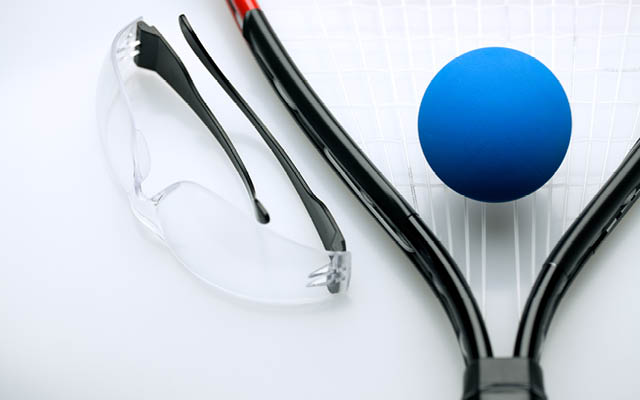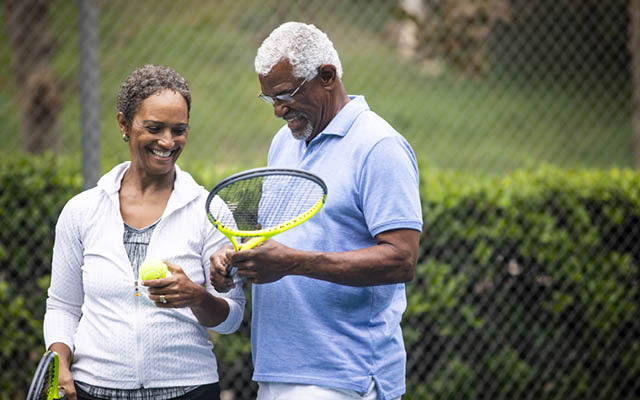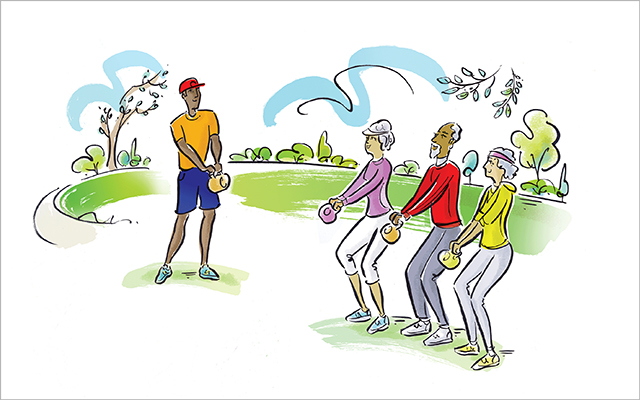The squeak of court shoes, the fast-paced action, the thwack of a rubber ball hitting the wall at high velocity: Racquetball can be a satisfying and fun social activity. And while getting started requires only the ability to swing a racquet, mastering the sport is a unique challenge.
“Racquetball offers astronomical health benefits,” says Sudsy Monchik, a professional racquetball player and coach who began playing at age 7 and went on to become a five-time world champion.
The sport engages both body and mind, improving cardiovascular fitness, agility, mobility, coordination, and reaction time. “Racquetball is a combination of aerobic and anaerobic exercise — and you’re not looking at the clock like you are on a treadmill,” explains fellow pro and coach Cliff Swain, who along with Monchik leads racquetball clinics across the country.
“People who have barely played can get a much better workout than in other sports because it is full of multidirectional demands.”
Racquetball is relatively safe, making it a lifelong sport. “Many people are still playing into their 80s, unlike other sports,” says Monchik.
Racquetball differs from tennis in several ways. “In tennis, it’s extremely difficult to get the ball over the net and in the inbox, and a lot of the time is spent picking up balls around the court,” he says. “The racquetball mostly comes back to the middle. The rules are simpler and the rallies are longer.”
To up your racquetball game, there are several strategic points to consider, says John Wilinski, Life Time’s national racquetball, squash, and pickleball manager. For example, many players position themselves too far forward in the court.
“Aim to stay back behind the safety line after you hit. This does two things: It gives you more time to hit the next shot and allows you to cover more of the court defensively.”
Another common mistake is aiming too low on the front wall. “It may cause the ball to hit the floor before it hits the front wall, costing you the point,” Wilinski explains. “Aim higher to keep the ball in play.”
Practice the drills here to improve your performance and enjoyment while getting a great workout.
Technique Tips & Drills
In the Gym
Resistance-Band Rows
Racquetball success depends on a strong and consistent swing, which requires a stable, mobile trunk and upper body, says Monchik. Upper-body rows are an excellent way to build strength through the middle and upper back, lats, and shoulders. Rowing also enhances mobility through the scapulae and improves stability in the thoracic spine and deep abdominals. He recommends the following move for its ease and minimal equipment.
- Loop a handled resistance band around a horizontal bar. With a handle in each hand and arms extended, step back until there is tension on the band.
- Keeping your back straight and a slight bend in the knees, draw your shoulder blades down and back, then pull the handles toward your chest.
- Perform three sets of 15, resting one minute in between.
Burpees
For developing explosive power, Swain recommends burpees — a do-anywhere, body-weight-only move. Burpees will build your quickness as well as the cardio capacity you need to keep up on the court. Eliminate the pushup at the bottom and focus on powering the descent, ascent, and jump through your hips.
- Standing with your feet shoulder width apart and arms at your sides, squat down and place your hands on the floor, about shoulder width apart.
- Keeping your arms extended, jump or step your legs back to land in a high plank position. Your body will form a straight line from head to heels.
- Jump or step your feet toward your hands to return to the squat. Stand up fully and jump into the air (if possible).
- Perform as many good-form burpees as you can in one minute. Each session, aim to increase your total number.
On the Court
Drill 1: Jumping in Place
Strengthening your core and lower body will build power and explosiveness to help you pivot quickly on the court. Monchik recommends this drill:
- On the court or in the gym, with enough space around you to swing your racquet, assume an athletic stance, with feet directly below your hips.
- Jump forward to land on your right foot and then backward to land on your left foot. Repeat with the left foot leading, not stopping, while swinging the racquet in an alternate direction. It’s like running in place, only you’re jumping.
- Keep the shoulders level, back erect, and head forward.
- Do three sets of 15 seconds each, with one minute of rest between sets.
Drill 2: Drop and Hit
Shot accuracy is essential for a strong racquetball game, and Wilinski loves this exercise for the way it develops your consistency.
- Stand near center court, drop the ball, and hit it to the front wall, aiming at a target about 2 feet from the floor.
- Practice getting your racquet up and ready as quickly as possible. Watch the ball until it hits your strings to improve your aim.
- Hit 100 shots on your forehand side, then 100 on your backhand side.
Drill 3: Lateral Shuffle
Quick directional changes are a key aspect of racquetball: Players shift, reach, slide, and pivot to hit the ball. This requires a combination of strength, power, and agility on a lateral (side-to-side) plane. The lateral shuffle challenges the entire lower body, firing up the glutes — particularly the side-butt muscles of the hips that initiate and control side-to-side motion — as well as the quads and calves. Try this drill as part of your pregame warm-up.
- Standing with racquet in hand and feet about hip width apart, assume an athletic quarter-squat stance with hips loaded.
- Shuffle four steps to the right as quickly as you can with control, then shuffle four steps to the left. Stay light on your forefoot and try to push the ground away with your trailing leg instead of pulling yourself to the side with your lead leg.
- Make sure your glutes and core are engaged, and keep your chest high (not hunched forward) to keep your nose over your toes. Do not straighten your legs (keep your center of gravity low), and minimize bouncing up and down (this is not a side skip).
- As your agility improves, incorporate swinging the racquet to coordinate upper- and lower-body movement.
This originally appeared as “Order on the Court” in the October 2019 print issue of Experience Life.




This Post Has 0 Comments